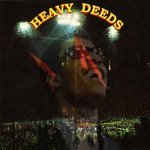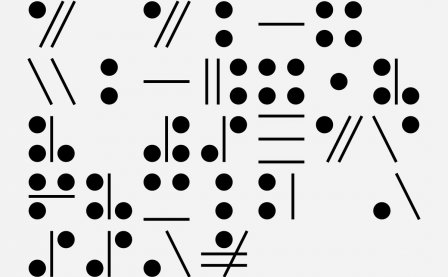Cameron Stallones has a very mystical way of discussing his craft. In a July [interview with TMT->http://www.tinymixtapes.com/Sun-Araw,9364], the man behind Sun Araw used a syntax seldom heard from other musicians. Building “resonant fields,” establishing a “language,” and “speaking the word,” Cameron Stallones and his Not Not Fun brethren keep busy and remain prolific. Sun Araw sounds the way Cameron Stallones talks — otherworldly, esoteric, and deep — and on Heavy Deeds, the sounds are congealed and harnessed into what very well may be Sun Araw’s most accessible record to date.
Stallones wades through the same sonic swamps and valleys he has already conquered on previous releases. There is still very much a throwback sound, like what a lonely record collector might hear in deep sleep. He grabs his influences of decades past, covers them in a translucent haze, and plods through the opaque muck for long stretches of time. The album art follows the established cut-and-paste aesthetic, with an old Polaroid of a full stadium just behind the fog of a big smiling Stevie Wonder at his prime and a campy typeface emblazoned upon the front: Heavy Deeds. "Heavy Deeds"! A name that could be cinematic, could be sardonic, could be stoic and sad, and is probably all of those simultaneously.
As the name suggests, each song here is a gospel, one that weighs heavily on your mind and body. While the album does sound very much like Sun Araw, it actually leaps many steps forward and expands upon an already established sound. Where The Phynx consisted of slow and methodical psychedelic rock songs re-imagined as drones and religious passages and Beach Head was Neil Young and Shinki Chen taking acid on a beach, Heavy Deeds is afrobeat in REM sleep. For all of the worldly influence, it remains an amalgam of all things high and low, as the ornate packaging suggests. Yes, “Hustle and Bustle” is a sophisticated, slow, fuzzy, and tropical bliss-out, but the organ in the beginning sounds as though it could be “Slow Ride” if you're not listening closely. The reverb-laden guitar solo in the second half of the song seems to come right out of a Funkadelic album. Indeed, the organ and guitar provide an acid-drenched 60s vibe at one moment and a gut and a mustache at another, often within the same song. All the while, the spare percussion pulsates.
Still, there seems to be more to this album than that. The theory of the word, as Stallones himself would put it, isn’t enough in analyzing this record. Yeah, it is a send-up of many different eras, but while so many artists are forging that same territory with any number of different time periods and sounds — many of them on the same label — the sounds Sun Araw is delivering here seem leaps and bounds ahead of it all. It is the way each individual limb is approached in the song, each instrument’s role in the overall experience. Album closer “All Night Long” starts innocuously enough, with a simple vocal melody smothered in filters and effects. The bass is upright, and the organ is soloing over the whole thing. This continues and builds until the shaker and handclaps reach their loudest state. Slowly but surely, everyone is playing. The composition of this song, and every song on the album at a certain point, feels very similar to those on Bitches Brew: there don’t appear to be sections for solos -- where each instrument takes a turn, or an instrument has a feature -- but rather, all the instruments vamp and come in at different times. By the end, noise comes from every direction, as though every limb is soloing simultaneously over a single chord. Organs envelop the canvas by the end of “All Night Long,” phasing lines and filling ears.
In the aforementioned interview, Stallones discussed how approaching the music of Sun Araw contrasts with approaching the music of the other group of which he is a member, Magic Lantern. While Magic Lantern’s methodology of music-making is “way less narrative and way less personal,” the Sun Araw approach consists of trying to “really drop-in/drop-out for a good chunk of time, wade through whatever tones are hanging around in the air.” Although the approach seems very solitary and individual, Heavy Deeds has a sound far from that. It feels communal, as though a hundred hands have touched each song. A record that’s as theoretically challenging as it is sonically pleasing, Heavy Deeds stands out as not only among the best of the year, but also among the best of Sun Araw’s catalog, and it lies in Stallones’ ability to layer and create the perfect sum total of what is occurring in his head.
1. Heavy Deeds
2. Hustle and Bustle
3. The Message
4. Get Low
5. All Night Long
6. Hey Mandala! (Bonus Track, from Predator Vision/Sun Araw Split LP)
More about: Sun Araw




